

如何搭建自己的神经网络
人工智能
描述
神经网络基本概念
(1)激励函数:
例如一个神经元对猫的眼睛敏感,那当它看到猫的眼睛的时候,就被激励了,相应的参数就会被调优,它的贡献就会越大。
下面是几种常见的激活函数:
x轴表示传递过来的值,y轴表示它传递出去的值:
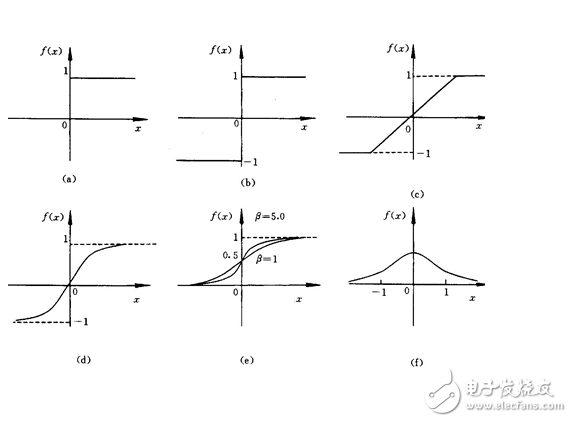
激励函数在预测层,判断哪些值要被送到预测结果那里:
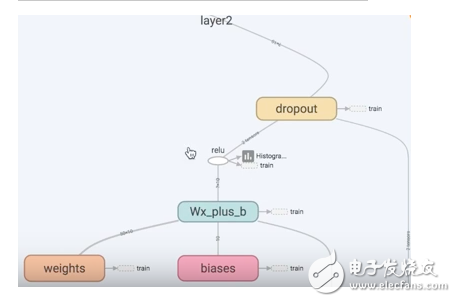
TensorFlow 常用的 activation function
(2)添加神经层:
输入参数有 inputs, in_size, out_size, 和 activation_function
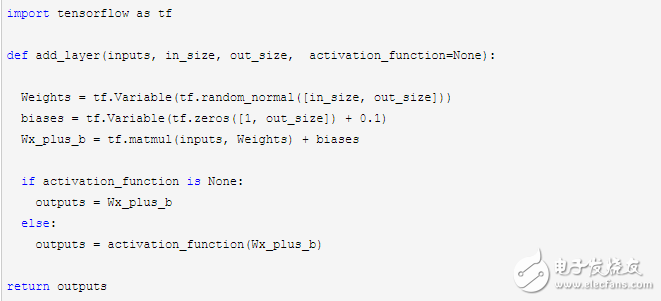
分类问题的 loss 函数 cross_entropy :

overfitting:
下面第三个图就是 overfitting,就是过度准确地拟合了历史数据,而对新数据预测时就会有很大误差:

Tensorflow 有一个很好的工具, 叫做dropout, 只需要给予它一个不被 drop 掉的百分比,就能很好地降低 overfitting。
dropout 是指在深度学习网络的训练过程中,按照一定的概率将一部分神经网络单元暂时从网络中丢弃,相当于从原始的网络中找到一个更瘦的网络,这篇博客中讲的非常详细
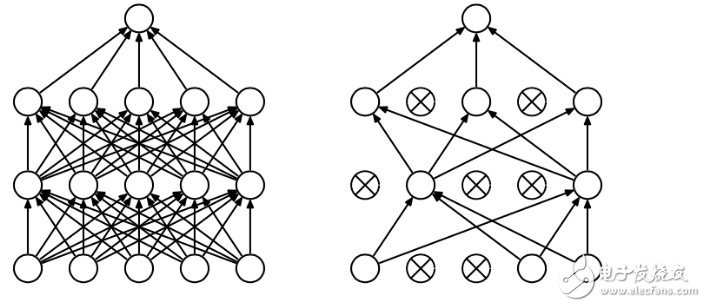
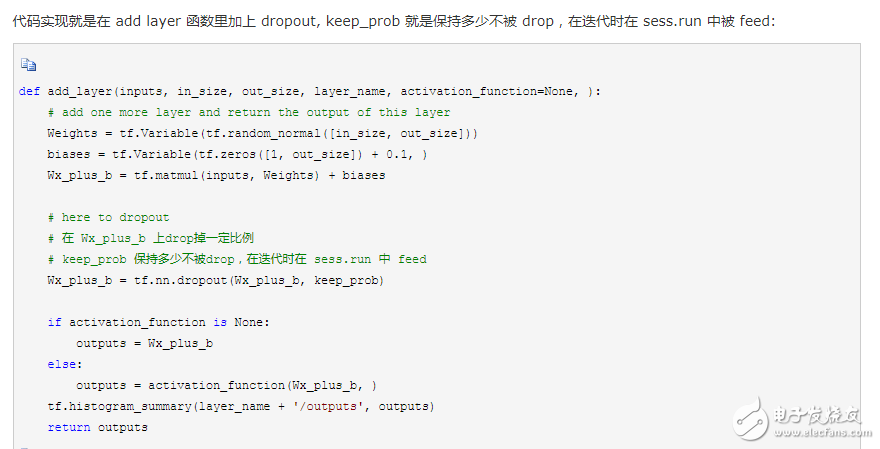
5. 可视化 Tensorboard
Tensorflow 自带 tensorboard ,可以自动显示我们所建造的神经网络流程图:
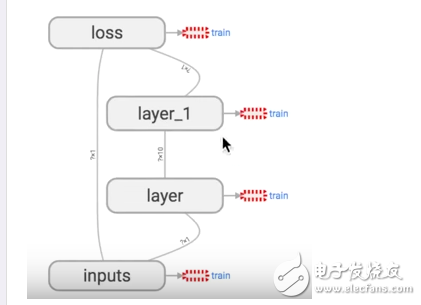
就是用 with tf.name_scope 定义各个框架,注意看代码注释中的区别:
import tensorflow as tf
def add_layer(inputs, in_size, out_size, activation_function=None):
# add one more layer and return the output of this layer
# 区别:大框架,定义层 layer,里面有 小部件
with tf.name_scope(‘layer’):
# 区别:小部件
with tf.name_scope(‘weights’):
Weights = tf.Variable(tf.random_normal([in_size, out_size]), name=‘W’)
with tf.name_scope(‘biases’):
biases = tf.Variable(tf.zeros([1, out_size]) + 0.1, name=‘b’)
with tf.name_scope(‘Wx_plus_b’):
Wx_plus_b = tf.add(tf.matmul(inputs, Weights), biases)
if activation_function is None:
outputs = Wx_plus_b
else:
outputs = activation_function(Wx_plus_b, )
return outputs
# define placeholder for inputs to network
# 区别:大框架,里面有 inputs x,y
with tf.name_scope(‘inputs’):
xs = tf.placeholder(tf.float32, [None, 1], name=‘x_input’)
ys = tf.placeholder(tf.float32, [None, 1], name=‘y_input’)
# add hidden layer
l1 = add_layer(xs, 1, 10, activation_function=tf.nn.relu)
# add output layer
prediction = add_layer(l1, 10, 1, activation_function=None)
# the error between prediciton and real data
# 区别:定义框架 loss
with tf.name_scope(‘loss’):
loss = tf.reduce_mean(tf.reduce_sum(tf.square(ys - prediction),
reduction_indices=[1]))
# 区别:定义框架 train
with tf.name_scope(‘train’):
train_step = tf.train.GradientDescentOptimizer(0.1).minimize(loss)
sess = tf.Session()
# 区别:sess.graph 把所有框架加载到一个文件中放到文件夹“logs/”里
# 接着打开terminal,进入你存放的文件夹地址上一层,运行命令 tensorboard --logdir=‘logs/’
# 会返回一个地址,然后用浏览器打开这个地址,在 graph 标签栏下打开
writer = tf.train.SummaryWriter(“logs/”, sess.graph)
# important step
sess.run(tf.initialize_all_variables())
运行完上面代码后,打开 terminal,进入你存放的文件夹地址上一层,运行命令 tensorboard --logdir=‘logs/’ 后会返回一个地址,然后用浏览器打开这个地址,点击 graph 标签栏下就可以看到流程图了
6. 保存和加载训练好了一个神经网络后,可以保存起来下次使用时再次加载:import tensorflow as tf
import numpy as np
## Save to file
# remember to define the same dtype and shape when restore
W = tf.Variable([[1,2,3],[3,4,5]], dtype=tf.float32, name=‘weights’)
b = tf.Variable([[1,2,3]], dtype=tf.float32, name=‘biases’)
init= tf.initialize_all_variables()
saver = tf.train.Saver()
# 用 saver 将所有的 variable 保存到定义的路径
with tf.Session() as sess:
sess.run(init)
save_path = saver.save(sess, “my_net/save_net.ckpt”)
print(“Save to path: ”, save_path)
################################################
# restore variables
# redefine the same shape and same type for your variables
W = tf.Variable(np.arange(6).reshape((2, 3)), dtype=tf.float32, name=“weights”)
b = tf.Variable(np.arange(3).reshape((1, 3)), dtype=tf.float32, name=“biases”)
# not need init step
saver = tf.train.Saver()
# 用 saver 从路径中将 save_net.ckpt 保存的 W 和 b restore 进来
with tf.Session() as sess:
saver.restore(sess, “my_net/save_net.ckpt”)
print(“weights:”, sess.run(W))
print(“biases:”, sess.run(b))
#p##e#
简单搭建自己的神经网络
1. 模型阐述
假设我们有下面的一组数据

对于上面的表格,我们可以找出其中的一个规律是:
输入的第一列和输出相同
那对于输入有3列,每列有0和1两个值,那可能的排列有(2^3=8)种,但是此处只有4种,那么在有限的数据情况下,我们应该怎么预测其他结果呢?
看代码:
%matplotlib inline
%config InlineBackend.figure_format = ‘retina’
from numpy import exp, array, random, dot
class NeuralNetwork():
def __init__(self):
# Seed the random number generator, so it generates the same numbers
# every time the program runs.
random.seed(1)
# We model a single neuron, with 3 input connections and 1 output connection.
# We assign random weights to a 3 x 1 matrix, with values in the range -1 to 1
# and mean 0.
self.synaptic_weights = 2 * random.random((3, 1)) - 1
self.sigmoid_derivative = self.__sigmoid_derivative
# The Sigmoid function, which describes an S shaped curve.
# We pass the weighted sum of the inputs through this function to
# normalise them between 0 and 1.
def __sigmoid(self, x):
return 1 / (1 + exp(-x))
# The derivative of the Sigmoid function.
# This is the gradient of the Sigmoid curve.
# It indicates how confident we are about the existing weight.
def __sigmoid_derivative(self, x):
return x * (1 - x)
# We train the neural network through a process of trial and error.
# Adjusting the synaptic weights each time.
def train(self, training_set_inputs, training_set_outputs, number_of_training_iterations):
for iteration in range(number_of_training_iterations):
# Pass the training set through our neural network (a single neuron)。
output = self.think(training_set_inputs)
# Calculate the error (The difference between the desired output
# and the predicted output)。
error = training_set_outputs - output
# Multiply the error by the input and again by the gradient of the Sigmoid curve.
# This means less confident weights are adjusted more.
# This means inputs, which are zero, do not cause changes to the weights.
adjustment = dot(training_set_inputs.T, error * self.__sigmoid_derivative(output))
# Adjust the weights.
self.synaptic_weights += adjustment
# The neural network thinks.
def think(self, inputs):
# Pass inputs through our neural network (our single neuron)。
return self.__sigmoid(dot(inputs, self.synaptic_weights))
#Intialise a single neuron neural network.
neural_network = NeuralNetwork()
print(“Random starting synaptic weights: ”)
print(neural_network.synaptic_weights)
# The training set. We have 4 examples, each consisting of 3 input values# and 1 output value.
training_set_inputs = array([[0, 0, 1], [1, 1, 1], [1, 0, 1], [0, 1, 1]])
training_set_outputs = array([[0, 1, 1, 0]]).T
# Train the neural network using a training set.# Do it 10,000 times and make small adjustments each time.
neural_network.train(training_set_inputs, training_set_outputs, 10000)
print(“New synaptic weights after training: ”)
print(neural_network.synaptic_weights)
# Test the neural network with a new situation.
print(“Considering new situation [1, 0, 0] -》 ?: ”)
print(neural_network.think(array([1, 0, 0])))
Random starting synaptic weights: [[-0.16595599]
[ 0.44064899]
[-0.99977125]]
New synaptic weights after training: [[ 9.67299303]
[-0.2078435 ]
[-4.62963669]]
Considering new situation [1, 0, 0] -》 ?: [ 0.99993704]
以上代码来自:https://github.com/llSourcell/Make_a_neural_network
现在我们来分析下具体的过程:
第一个我们需要注意的是sigmoid function,其图如下:
import matplotlib.pyplot as pltimport numpy as np
def sigmoid(x):
a = []
for item in x:
a.append(1/(1+np.exp(-item)))
return a
x = np.arange(-6., 6., 0.2)
sig = sigmoid(x)
plt.plot(x,sig)
plt.grid()
plt.show()
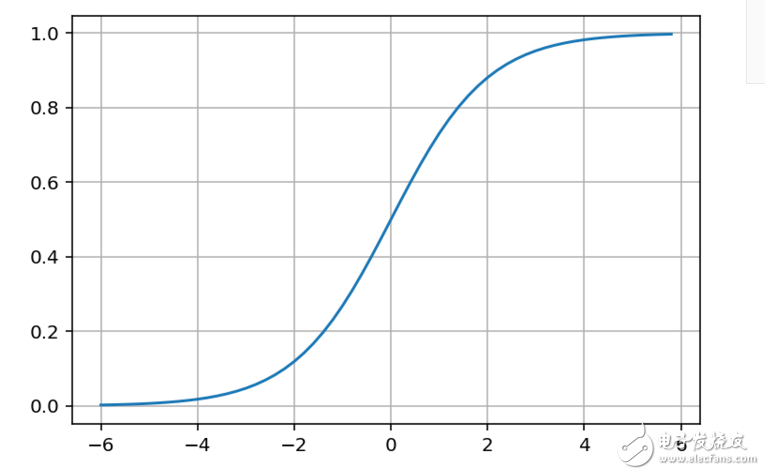
我们可以看到sigmoid函数将输入转换到了0-1之间的值,而sigmoid函数的导数是:
def __sigmoid_derivative(self, y):
return y * (1 - y)
其具体的含义看图:
def sigmoid_derivative(x):
y = 1/(1+np.exp(-x))
return y * (1-y)
def derivative(point):
dx = np.arange(-0.5,0.5,0.1)
slope = sigmoid_derivative(point)
return [point+dx,slope * dx + 1/(1+np.exp(-point))]
x = np.arange(-6., 6., 0.1)
sig = sigmoid(x)
point1 = 2
slope1 = sigmoid_derivative(point1)
plt.plot(x,sig)
x1,y1 = derivative(point1)
plt.plot(x1,y1,linewidth=5)
x2,y2 = derivative(0)
plt.plot(x2,y2,linewidth=5)
x3,y3 = derivative(-4)
plt.plot(x3,y3,linewidth=5)
plt.grid()
plt.show()
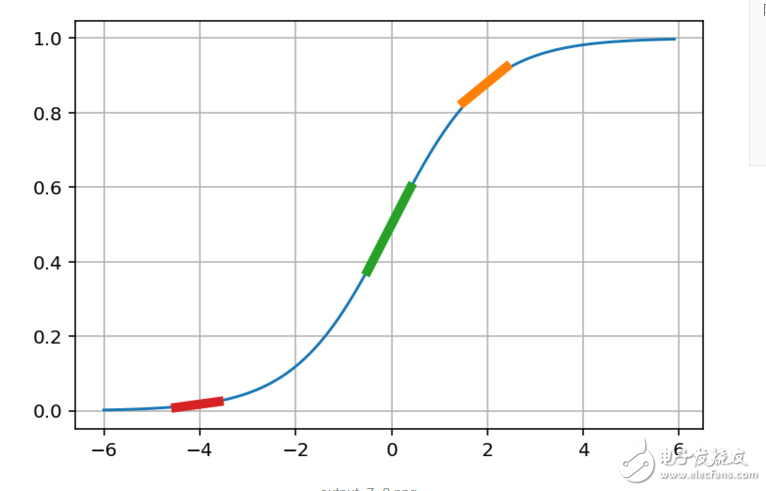
现在我们来根据图解释下实际的含义:
1. 首先输出是0到1之间的值,我们可以将其认为是一个可信度,0不可信,1完全可信
2. 当输入是0的时候,输出是0.5,什么意思呢?意思是输出模棱两可
基于以上两点,我们来看下上面函数的中的一个计算过程:
adjustment = dot(training_set_inputs.T, error * self.__sigmoid_derivative(output))
这个调整值的含义我们就知道了,当输出接近0和1时候,我们已经预测的挺准了,此时调整就基本接近于0了
而当输出为0.5左右的时候,说明预测完全是瞎猜,我们就需要快速调整,因此此时的导数也是最大的,即上图的绿色曲线,其斜度也是最大的
基于上面的一个讨论,我们还可以有下面的一个结论:
1. 当输入是1,输出是0,我们需要不断减小 weight 的值,这样子输出才会是很小,sigmoid输出才会是0
2. 当输入是1,输出是1,我们需要不断增大 weight 的值,这样子输出才会是很大,sigmoid输出才会是1
这时候我们再来看下最初的数据,

我们可以断定输入1的weight值会变大,而输入2,3的weight值会变小。
根据之前训练出来的结果也支持了我们的推断:
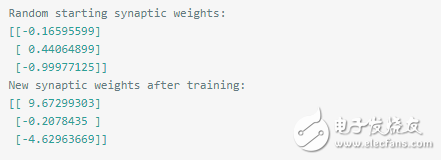
2. 扩展
我们来将上面的问题稍微复杂下,假设我们的输入如下:

此处我们只是改变一个值,此时我们再次训练呢?
我们观察上面的数据,好像很难再像最初一样直接观察出 输出1 == 输出 的这种简单的关系了,我们要稍微深入的观察下了
· 首先输入3都是1,看起来对输出没什么影响
· 接着观察输入1和输入2,似乎只要两者不同,输出就是1
基于上面的观察,我们似乎找不到像输出1 == 输出这种 one-to-one 的关系了,我们有什么办法呢?
这个时候,就需要引入 hidden layer,如下表格:

此时我们得到中的中间输入和最后输出就还是原来的一个 输出1 == 输出 关系了。
上面介绍的这种方法就是深度学习的最简单的形式
深度学习就是通过增加层次,不断去放大输入和输出之间的关系,到最后,我们可以从复杂的初看起来毫不相干的数据中,找到一个能一眼就看出来的关系
此处我们还是用之前的网络来训练
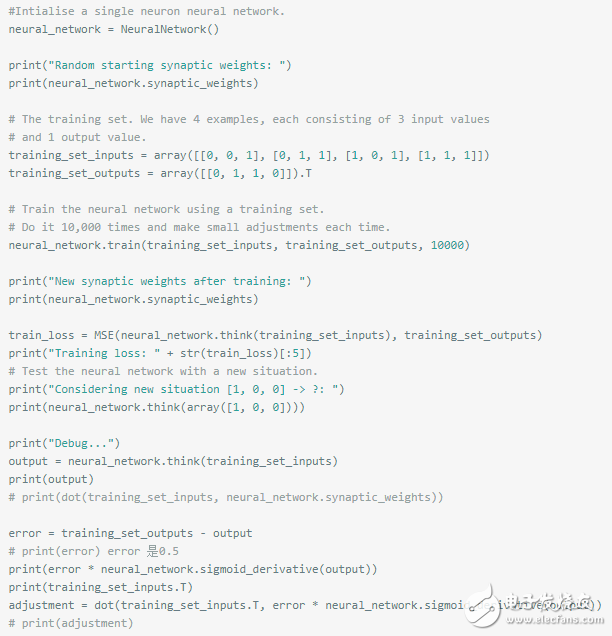
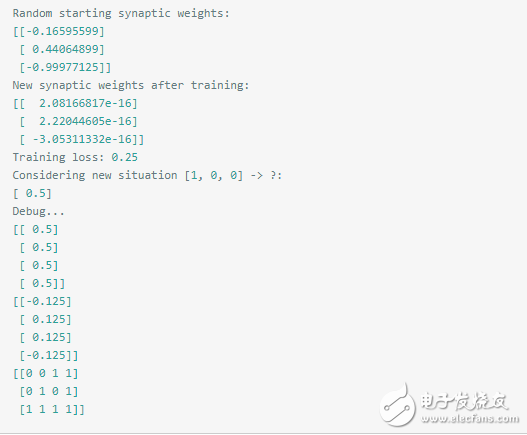
此处我们训练可以发现,此处的误差基本就是0.25,然后预测基本不可信。0.5什么鬼!
由数据可以看到此处的weight都已经非常非常小了,然后斜率是0.5,
由上面打印出来的数据,已经达到平衡,adjustment都是0了,不会再次调整了。
由此可以看出,简单的一层网络已经不能再精准的预测了,只能增加复杂度了。
下面我们来加一层再来看下:
class TwoLayerNeuralNetwork(object):
def __init__(self, input_nodes, hidden_nodes, output_nodes, learning_rate):
# Set number of nodes in input, hidden and output layers.
self.input_nodes = input_nodes
self.hidden_nodes = hidden_nodes
self.output_nodes = output_nodes
np.random.seed(1)
# Initialize weights
self.weights_0_1 = np.random.normal(0.0, self.hidden_nodes**-0.5,
(self.input_nodes, self.hidden_nodes)) # n * 2
self.weights_1_2 = np.random.normal(0.0, self.output_nodes**-0.5,
(self.hidden_nodes, self.output_nodes)) # 2 * 1
self.lr = learning_rate
#### Set this to your implemented sigmoid function ####
# Activation function is the sigmoid function
self.activation_function = self.__sigmoid
def __sigmoid(self, x):
return 1 / (1 + np.exp(-x))
def __sigmoid_derivative(self, x):
return x * (1 - x)
def train(self, inputs_list, targets_list):
# Convert inputs list to 2d array
inputs = np.array(inputs_list,ndmin=2) # 1 * n
layer_0 = inputs
targets = np.array(targets_list,ndmin=2) # 1 * 1
#### Implement the forward pass here ####
### Forward pass ###
layer_1 = self.activation_function(layer_0.dot(self.weights_0_1)) # 1 * 2
layer_2 = self.activation_function(layer_1.dot(self.weights_1_2)) # 1 * 1
#### Implement the backward pass here ####
### Backward pass ###
# TODO: Output error
layer_2_error = targets - layer_2
layer_2_delta = layer_2_error * self.__sigmoid_derivative(layer_2)# y = x so f‘(h) = 1
layer_1_error = layer_2_delta.dot(self.weights_1_2.T)
layer_1_delta = layer_1_error * self.__sigmoid_derivative(layer_1)
# TODO: Update the weights
self.weights_1_2 += self.lr * layer_1.T.dot(layer_2_delta) # update hidden-to-output weights with gradient descent step
self.weights_0_1 += self.lr * layer_0.T.dot(layer_1_delta) # update input-to-hidden weights with gradient descent step
def run(self, inputs_list):
# Run a forward pass through the network
inputs = np.array(inputs_list,ndmin=2)
#### Implement the forward pass here ####
layer_1 = self.activation_function(inputs.dot(self.weights_0_1)) # 1 * 2
layer_2 = self.activation_function(layer_1.dot(self.weights_1_2)) # 1 * 1
return layer_2def MSE(y, Y):
return np.mean((y-Y)**2)
# import sys
training_set_inputs = array([[0, 0, 1], [0, 1, 1], [1, 0, 1], [1, 1, 1]])
training_set_outputs = array([[0, 1, 1, 0]]).T
### Set the hyperparameters here ###
epochs = 20000
learning_rate = 0.1
hidden_nodes = 4
output_nodes = 1
N_i = 3
network = TwoLayerNeuralNetwork(N_i, hidden_nodes, output_nodes, learning_rate)
losses = {’train‘:[]}for e in range(epochs):
# Go through a random batch of 128 records from the training data set
for record, target in zip(training_set_inputs,
training_set_outputs):# print(target)
network.train(record, target)
train_loss = MSE(network.run(training_set_inputs), training_set_outputs)
sys.stdout.write(“ Progress: ” + str(100 * e/float(epochs))[:4]
+ “% 。。。 Training loss: ” + str(train_loss)[:7])
losses[’train‘].append(train_loss)
print(“ ”)
print(“After train,layer_0_1: ”)
print(network.weights_0_1)
print(“After train,layer_1_2: ”)
print(network.weights_1_2)# Test the neural network with a new situation.
print(“Considering new situation [1, 0, 0] -》 ?: ”)
print(network.run(array([1, 0, 0])))
Progress: 99.9% 。。。 Training loss: 0.00078
After train,layer_0_1:
[[ 4.4375838 -3.87815184 1.74047905 -5.12726884]
[ 4.43114847 -3.87644617 1.71905492 -5.10688387]
[-6.80858063 0.76685389 1.89614363 1.61202043]]
After train,layer_1_2:
[[-9.21973137]
[-3.84985864]
[ 4.75257888]
[-6.36994226]]
Considering new situation [1, 0, 0] -》 ?:
[[ 0.00557239]]
layer_1=network.activation_function(training_set_inputs.dot(network.weights_0_1))
print(layer_1)
layer_2 = network.activation_function(layer_1.dot(network.weights_1_2))
print(layer_2)
[[ 2.20482250e-01 9.33639853e-01 6.30402293e-01 6.24775766e-02]
[ 1.77659862e-02 9.99702482e-01 8.64290928e-01 9.26611880e-01]
[ 6.94975743e-01 8.90040645e-02 8.51261229e-01 2.06917379e-04]
[ 1.27171786e-01 9.58904341e-01 9.55296949e-01 3.77322214e-02]]
[[ 0.02374213]
[ 0.97285992]
[ 0.97468116]
[ 0.02714965]]
最后总结:我们发现在扩展中,我们只是简单的改变了两个输入值,此时再次用一层神经网络已经难以预测出正确的数据了,此时我们只能通过将神经网络变深,这个过程其实就是再去深度挖掘数据之间关系的过程,此时我们的2层神经网络相比较1层就好多了。
- 相关推荐
- 热点推荐
- BP神经网络
-
NMSIS神经网络库使用介绍2025-10-29 111
-
人工神经网络原理及下载2008-06-19 9722
-
神经网络教程(李亚非)2012-03-20 56739
-
神经网络简介2012-08-05 3439
-
神经网络基本介绍2018-01-04 1919
-
【PYNQ-Z2试用体验】基于PYNQ的神经网络自动驾驶小车 - 项目规划2019-03-02 5013
-
全连接神经网络和卷积神经网络有什么区别2019-06-06 5916
-
卷积神经网络如何使用2019-07-17 2748
-
【案例分享】ART神经网络与SOM神经网络2019-07-21 3182
-
如何构建神经网络?2021-07-12 1864
-
基于BP神经网络的PID控制2021-09-07 2588
-
轻量化神经网络的相关资料下载2021-12-14 2034
-
神经网络移植到STM32的方法2022-01-11 3155
-
如何使用Numpy搭建神经网络2019-05-18 4064
-
卷积神经网络模型搭建2023-08-21 1591
全部0条评论

快来发表一下你的评论吧 !

